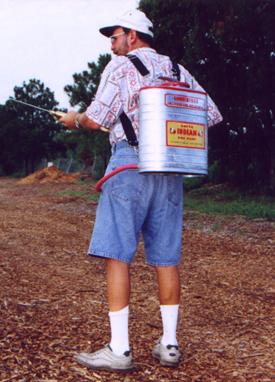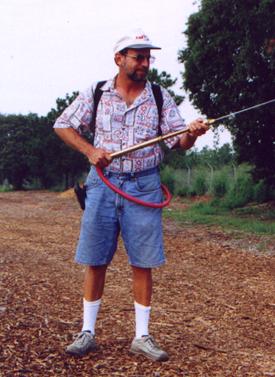

Safety Issues
10 August 2000
How important is this
sport to you?
|
  Turbine
powered models can crash for all of the same reasons that other R/C model
airplanes crash and a few more. We can add to the list, increased power and
weight loadings that put more demands on piloting skills. Jet models are new to
the hobby and some are being operated by inexperienced people. The rapid growth
of this sector of R/C means that the incidence of crashes is going to increase
unless each of us becomes more involved in safety awareness and becomes
proactive. Turbine
powered models can crash for all of the same reasons that other R/C model
airplanes crash and a few more. We can add to the list, increased power and
weight loadings that put more demands on piloting skills. Jet models are new to
the hobby and some are being operated by inexperienced people. The rapid growth
of this sector of R/C means that the incidence of crashes is going to increase
unless each of us becomes more involved in safety awareness and becomes
proactive.
  It is interesting to note
that the high incidence of crashing is not occurring at the organized jet
events. The elements of organization and experienced people, combined with
on-site water fire extinguishing equipment, contributes to the safe operations
at recent events. It is interesting to note
that the high incidence of crashing is not occurring at the organized jet
events. The elements of organization and experienced people, combined with
on-site water fire extinguishing equipment, contributes to the safe operations
at recent events.
  A visit to
a local R/C club field on a Sunday morning was a reminder for me of what
inexperience with radio controlled models produces - a lot of crashes. Low
powered, propeller driven models with glow engines and a few ounces of fuel on
board were hitting the turf rather frequently. These "modelers to be" are
learning about the hobby and as long as they do not hit a human being, the
results of their learning curve are relatively inert. It is very rare for these
types of models to cause a fire. A visit to
a local R/C club field on a Sunday morning was a reminder for me of what
inexperience with radio controlled models produces - a lot of crashes. Low
powered, propeller driven models with glow engines and a few ounces of fuel on
board were hitting the turf rather frequently. These "modelers to be" are
learning about the hobby and as long as they do not hit a human being, the
results of their learning curve are relatively inert. It is very rare for these
types of models to cause a fire.
  The increased possibility of a post crash fire separates our craft
from the "relatively inert" category and therefore should raise our
awareness. The increased possibility of a post crash fire separates our craft
from the "relatively inert" category and therefore should raise our
awareness.
  Jets should not crash for
all of the same reasons and frequency that trainer R/C models do. The AMA's
"Turbine Waiver" requirement is an attempt to signal the importance of
experience and good judgment in the operation of jet models. The Jet Pilot's
Organization (JPO) has also posted a number of safety oriented articles in the
Contrails newsletter and I know from several conversations with JPO leaders
that they are concerned. But the crashes and fires continue at an accelerating
rate. Jets should not crash for
all of the same reasons and frequency that trainer R/C models do. The AMA's
"Turbine Waiver" requirement is an attempt to signal the importance of
experience and good judgment in the operation of jet models. The Jet Pilot's
Organization (JPO) has also posted a number of safety oriented articles in the
Contrails newsletter and I know from several conversations with JPO leaders
that they are concerned. But the crashes and fires continue at an accelerating
rate.
  Some years ago when the
AMA was formulating the turbine waiver regulations I submitted a written
proposal to them suggesting that a minimum requirement to get a modeler turbine
qualified would be that he accumulate 100 flights on a medium to high
performance ducted fan powered jet. Certain exceptions for highly skilled
pilots could be allowed. Those of you who have accomplished this know the
valuable experience you gained in doing so. Your turbine powered models are
less likely to self-destruct in flight and your piloting skills were sharpened.
Above all, this experience allows you to make sound judgments about the
readiness of you and your model jet. The AMA chose to significantly reduce the
level of experience required to obtain a waiver. Some years ago when the
AMA was formulating the turbine waiver regulations I submitted a written
proposal to them suggesting that a minimum requirement to get a modeler turbine
qualified would be that he accumulate 100 flights on a medium to high
performance ducted fan powered jet. Certain exceptions for highly skilled
pilots could be allowed. Those of you who have accomplished this know the
valuable experience you gained in doing so. Your turbine powered models are
less likely to self-destruct in flight and your piloting skills were sharpened.
Above all, this experience allows you to make sound judgments about the
readiness of you and your model jet. The AMA chose to significantly reduce the
level of experience required to obtain a waiver.
  We are seeing the results of that course of action, far too many
crashes of turbine powered models in the hands of the inexperienced. It was
rumored that some people on the AMA Safety Committee thought that my proposal
was motivated to protect BVM sales of Ducted Fan equipment. We are seeing the results of that course of action, far too many
crashes of turbine powered models in the hands of the inexperienced. It was
rumored that some people on the AMA Safety Committee thought that my proposal
was motivated to protect BVM sales of Ducted Fan equipment.
  If your answer to the opening question is VERY
IMPORTANT, may I suggest that the answer to reducing the number of crashes lies
with each one of us. We must first see to it that our own models and related
equipment are properly prepared and maintained and that they never launch
unless absolutely ready, and, that the appropriate fire fighting equipment is
on hand - it has been proven to work. (Scroll down this page to view the first
post on this issue) If your answer to the opening question is VERY
IMPORTANT, may I suggest that the answer to reducing the number of crashes lies
with each one of us. We must first see to it that our own models and related
equipment are properly prepared and maintained and that they never launch
unless absolutely ready, and, that the appropriate fire fighting equipment is
on hand - it has been proven to work. (Scroll down this page to view the first
post on this issue)
  Next, we
must extend this level of concern to help the "new guy" and his jet ascend to
these same criteria for safe operations. If he is not receptive, we must have
the guts to say "don't fly that thing until it and you are properly prepared."
Don't let him ruin your sport. The level of concern is surely heightened if you
are operating in a fire sensitive area. Next, we
must extend this level of concern to help the "new guy" and his jet ascend to
these same criteria for safe operations. If he is not receptive, we must have
the guts to say "don't fly that thing until it and you are properly prepared."
Don't let him ruin your sport. The level of concern is surely heightened if you
are operating in a fire sensitive area.
  The single most important emergency procedure that a jet pilot and
helper (caller) must be able to execute is to shut the engine down before
impact. Just a few seconds of cool down significantly reduces the fire
potential. Rehearse this procedure before take off. The single most important emergency procedure that a jet pilot and
helper (caller) must be able to execute is to shut the engine down before
impact. Just a few seconds of cool down significantly reduces the fire
potential. Rehearse this procedure before take off.
  Additionally, have the local fire department's phone number
programmed into your cell phone. Dry conditions and wind make time the most
critical element in bringing the situation under control. Additionally, have the local fire department's phone number
programmed into your cell phone. Dry conditions and wind make time the most
critical element in bringing the situation under control.
If I may quote
Smokey the Bear - "Only you can prevent forest fires."
Bob
Violett
  As a
manufacturer, BVM was the first to introduce Kevlar fuel tanks and metal tank
caps to help reduce the burst-on-impact potential. Our testing of these devices
(when properly assembled and installed) confirmed their viability to contain a
burst under many conditions. As a
manufacturer, BVM was the first to introduce Kevlar fuel tanks and metal tank
caps to help reduce the burst-on-impact potential. Our testing of these devices
(when properly assembled and installed) confirmed their viability to contain a
burst under many conditions.
  BVM is
continuing to investigate other measures that might enhance our safety of
operations and we will keep you informed. BVM is
continuing to investigate other measures that might enhance our safety of
operations and we will keep you informed.
  Our field representatives and factory personnel are also available
to help each new customer learn to operate safely and be
successful. Our field representatives and factory personnel are also available
to help each new customer learn to operate safely and be
successful.
|
|
 
Mitch Weiss demonstrates the Indian Series
Water Pump
|
Contact Us
All graphics, photos, and text
Copyright 2011 BVM, Inc.
Use of graphics or photos without written permission from
BVM is
strictly prohibited.
|